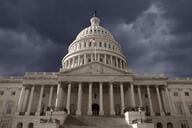You have /5 articles left.
Sign up for a free account or log in.
With the recent news that Southern Vermont College will close -- following announcements by Green Mountain College, Newbury College and Mount Ida College, as well as the highly publicized financial problems at Hampshire College -- the role of regional accreditors in monitoring institutions’ financial stability has come into focus. Southern Vermont’s announcement came after a warning from the New England Commission of Higher Education that the college’s accreditation was in jeopardy because of financial problems.
People have raised concerns that accreditors have increased their scrutiny of financial issues, especially in the New England region, which has a heavy concentration of higher education institutions and a declining college-age population. The commission’s president, Barbara Brittingham, has, in fact, stated that “there are higher expectations than in the past.”
The commission should be commended for acting decisively in this case; too often regional accreditors do not warn financially troubled institutions soon enough. All regional accreditors publicly post their institutions’ accreditation status, with varying levels of detail, indicating problems and required follow-up. But in an unscientific survey of such statements about institutions that have been in the news recently for their financial woes, I found a surprising number of accrediting statements that do not mention inadequate financial resources as a problem -- even in statements posted only a few years before the bad financial news.
For example, Newbury College in Brookline, Mass., was judged “in substantial compliance with the Commission’s Standards for Accreditation” in March 2016, but it was put on probation for inadequate resources a little over two years later and then closed several months after that. Similarly, Wright State University’s reserves had shrunk by $130 million in five years by this past February, but their July 2016 report from the Higher Learning Commission put them on notice only for issues unrelated to inadequate financial resources. Sweet Briar College, whose near closure in 2015 was widely reported, was put on warning by its accreditor, the Southern Association of Colleges and Schools Commission on Colleges, in 2018. But the accreditor took no action in the time leading up to the institution’s 2015 closure announcement. Ironically, the forensic accountant hired by Saving Sweet Briar (the alumnae-led group that was responsible for reopening the college) wrote that as of August 2014, the accreditor had not flagged the institution, and therefore its financial situation could not be as dire as the then president and board claimed.
Unfortunately, however, that logic doesn’t work. I have been closely engaged in regional accreditation as a senior institutional administrator with accreditation responsibilities or as a reviewer for a regional accreditor in four of the major accreditation regions in the United States. My experience suggests the following three reasons for a failed early warning system for financial difficulty:
Failing to respect the importance of cash. Tuition-dependent institutions, which include most private colleges without large endowments and an increasing proportion of public institutions, are essentially cash operations. Colleges don’t close because they lack assets; they close because they run out of cash. But with the accrual-based accounting systems that they all use, which commingle cash and noncash assets in various ways, even a balanced budget can hide serious cash-based problems.
For example, I know of an institution that accepted about $1 million a year in “gifts in kind” -- donated horses for an equestrian program -- that had no cash value once they reached campus. (If their owners could have sold these horses, they would not have been donated.) From an accounting perspective, it is perfectly legitimate to count such gifts as revenue, but unless the institution has a $1 million cash surplus, a balanced budget on these terms hides a $1 million annual cash deficit. Unless the president and chief financial officer think in terms of cash, it can dwindle quickly.
Failing to consider the long-term implications of financial decisions. Consider this scenario: a college raises $23 million in cash and pledges for a new building. Because $14 million of the money raised is in pledges to be paid to the college in future years, the college takes out a $14 million construction loan to complete the building.
That’s a fairly standard procedure. Legally, the donors’ wishes have been fulfilled when the building is built, even though all the money is not yet in, so as the pledges are fulfilled, the college converts those funds to operating cash instead of using them to pay back the construction loan. (Although this is legal, it is unethical, but that is a separate internal and accreditation issue.) The construction loan is then refinanced and disappears into the rest of the college’s long-term debt.
For a few years everything is fine -- there is plenty of cash to be converted from restricted to unrestricted funds. So the president and board don’t worry about (or worse, are unaware of) the fact that that the real operational revenue taken in is smaller than the outgoing cash expenses by a few million dollars a year. Situations like this can be hidden from the board and even from a financially naïve president.
But after a few years, the pledges are all in, the cash has been spent down and expenses still exceed revenue. So the institution is left with a structural deficit that has been ignored, very little in cash reserves and a large, long-term debt that leaves the institution with no borrowing capacity. This is a triple threat that can bring on closure very quickly.
In hindsight, this trend should have been fully predictable. The institution would have focused on reducing its cash deficit instead of simply spending down its cash, but the institution failed to see it while it was happening because it had cash available every year. And only two years before these serious financial problems were recognized, the college had been given a clean bill of financial health from its accreditor, who saw nothing but a relatively balanced budget and adequate cash reserves.
This is an extreme example. But it illustrates the importance of focusing on long-term trends instead of the short term or relying only on a snapshot of current finances. The Composite Financial Index, a widely used indicator of financial health in higher education, combines a measure of the primary reserve ratio (which compares available reserves to annual operating demands), the viability ratio (the amount of debt that could be paid from reserves), the return on net assets (whether assets have increased or decreased over a given year) and the net operating revenues ratio (the extent to which operating revenues can fund operating expenses). The last measure -- which I would argue is the most important one -- counts for only 10 percent of the score. An asset-rich and temporarily cash-rich institution can do reasonably well on this index even if clearly identifiable long-term trends indicate trouble.
A culture of denial in the accreditation process itself. If the institution does not see or acknowledge financial problems, the accreditor probably won’t see them, either. Because the reaffirmation process starts with an institutional self-study, the institution gets to set the terms on which it is evaluated. That is a good way to respect institutional differences and autonomy, but it also opens opportunities for both obfuscation and honestly ignorant self-reporting.
A good evaluation team will look beyond the self-study and check its validity, but its members don’t necessarily know what they don’t know. Furthermore, the self-study tends to be a snapshot of an institution’s current status, so the long-term trends I’ve noted can be obscured.
Even if the institution does recognize problems, it has an incentive to put the best face on every aspect of its operations, and most self-studies try hard to show that the accreditor’s standards are being met. There are certainly exceptions: for example, the New England Commission on Higher Education commended Hampshire College for being candid about its financial challenges. But I know from experience that the attitude can be “We know we have problems, but we don’t want to add to those problems the possibility of being put on probation if we are too honest about our difficulties.” Presidents sometimes have an unwarranted faith that issues will resolve themselves before they have to be acknowledged to accrediting bodies or even the institution’s board.
How can this situation be fixed?
Boards, presidents and accreditors should require that the college or university annually track actual cash revenue and expenses, which should be pulled out of the financial statements and analyzed separately over time. Accreditors should also demand that institutions report operational cash positions each year so as to identify troubling patterns early.
Presidents and CFOs should look for anomalies in trends. For example, the situation I’ve described that produced a temporary cash influx from completed pledges was discovered when someone noticed that, over several years, cash was trending upward as enrollment was declining -- certainly an anomaly in a tuition-dependent institution. That should have set off warning bells immediately.
In self-studies, accreditors should require answers to specific questions that would reveal hidden negative financial trends. We have plenty of evidence from recent closures and near closures to identify what those questions might be. For example:
- What are the long-term trends in true operational revenue and expenses?
- Are there realistic long-term plans for maintaining a positive operational margin, accounting not only for basic operations but also for debt management, construction needs and changing demographics?
- Everyone looks at the size of the endowment, but does the endowment contain sufficient unrestricted and board-designated funds for program investment and emergencies?
- Most important, do the president and the board have an accurate understanding of the institution’s cash situation, and are they asking the right questions?
Finally, visiting accreditation teams should be trained to look for signs of financial trouble, especially regarding cash, that may be hidden in financial statements and self-studies.
There are plenty of reasons for colleges to close, and as Alice Brown has argued, those whose missions are no longer viable should close. But with more focused attention on cash flow and long-term trends, institutions and their accreditors can, at worst, better prepare for a closure or merger, if necessary. And, at best, they can fix problems before it’s too late.




